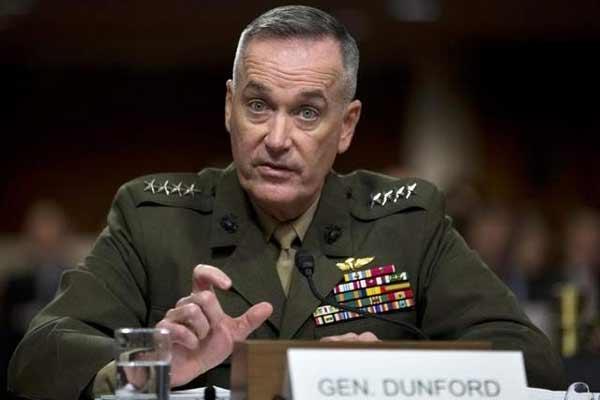The U.S. can still salvage a win in Afghanistan, the top U.S. commander said Wednesday.
If the American people are prepared to have U.S. troops stay there indefinitely and Afghan leaders commit to a post-2014 coalition presence, the return of the Taliban and their Al Qaeda allies can be prevented and an Afghan democracy can survive, said Marine Gen. Joseph Dunford.
"That is what winning will look like," Dunford, commander of the International Security Assistance Force, said in testimony to the Senate Armed Services Committee. "Despite all the skepticism around our mission, that is what winning looks like to me."
Dunford, who was expected to be on the short list to replace Gen. James Amos as the Marine commandant, told Congress that Al Qaeda was now in "survival mode" but would quickly regroup in Afghanistan and, in turn, pose an eventual threat to the homeland if U.S. troops left.
Most members of the Committee backed Dunford, but Sen. Joe Mancin, D-W.V., asked the general if the U.S. should maintain a "presence in perpetuity in Afghanistan, like in Korea?"
Dunford declined to give Mancin a timeline on how long U.S. troops would have to stay.
"If we can't do the job in 13 years, we're not going to get the job done," Mancin said.
The entire U.S. and NATO strategy was contingent on Afghan approval of a new Bilateral Security Agreement (BSA) that would allow for a post-2014 coalition presence, Dunford said.
Dunford predicted that a new Afghan president would sign the long-pending BSA, but just barely in time before he would have to order the "zero option" for a total pullout that would leave the Afghan National Security Forces (ANSF) on their own.
The U.S. and NATO have essentially given up on getting current Afghan President Hamid Karzai to sign the BSA, Dunford said. Presidential elections are scheduled to begin next month and a likely runoff would delay a new president's approval of the BSA until August, Dunford said.
"The risk to an orderly withdrawal begins to get high in September because of the number of tasks that need to be accomplished," Dunford said. President Obama has ordered the withdrawal of all U.S. combat forces at the end of the year, but he has committed to a post-2014 presence if the Afghans agree.
Dunford gave his most complete public accounting to date on what a U.S. and NATO presence would look like in 2015 and beyond.
Dunford said the plan was to have a total of 8,000-12,000 troops on the ground -- about two-thirds of them American -- "to address gaps in capabilities that are necessary for the ANSF to become self-sutainable," Dunford said.
Most of the force would be in support roles for ANSF in Kabul and at the Bagram Airfield north of the capital, Dunford said, but small contingents would be at bases in the four corners of the country.
In addition to the 8,000-12,000 troops, there would be an unspecified number of Special Operations forces to carry out counter-terror raids on Taliban and Al Qaeda leadership, Dunford said.
He also explained by the U.S. was choosing to scrap many of the same Mine Resistance Ambush Protected vehicles, the U.S. rushed into the warzone. Dunford told Congress it cost $50,000 to ship an MRAP back to the U.S. and $10,000 to destroy in Afghanistan. As the military tries to cut costs, the decision has been made to keep many in Afghanistan.
In his written statement submitted before the hearing, Dunford outlined the continuing threats.
"As we look to the remaining months of the ISAF campaign, we can expect the Taliban, the Haqqani network and other exremists to attempt a higher operational tempo than in previous years to disrupt the political process and prevent the signing of the BSA," Dunford said.
"Absent confidence and hope for a brighter future, many Afghans are planning for the worst," Dunford said. "Numerous reports cite the depreciation of the currency, plunging real estate prices, capital flight and young well-educated Afghans trying to emigrate," Dunford said.
Through last week, a total of 3,427 coalition troops -- 2,315 from the U.S. -- had been killed in Afghanistan.
Currently, there are about 32,000 U.S. troops in Afghanistan, down from a high of more than 100,000 in 2012. As the size of the force has diminished, and the ANSF have taken the lead, the casualties have also gone down markedly.
In the first two months this year, 14 U.S. troops have been killed, compared to 61 in the first two months of 2010 when the death toll was highest, according to the Defense Department and the website icasualties.org.
-- Richard Sisk can be reached at richard.sisk@monster.com





























